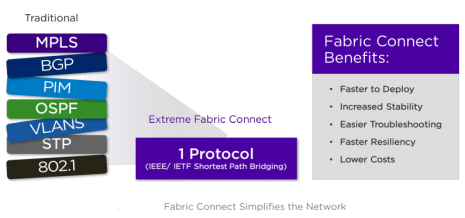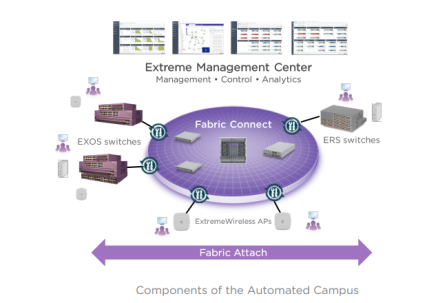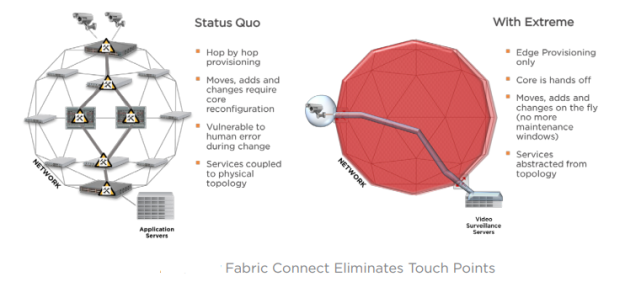It’s easy to become desensitized to the onslaught of marketing that surrounds networking concepts like “fabric” and “unified networks” when every vendor has their own version of them. Naturally, each marketing department promises that their solution is the best, but reality shines through when you start to look past the buzzwords for substance. I was recently introduced to (and impressed by) Extreme Networks’ own fabric accomplishments, and wrote about my impressions here. Soon after, I had the chance to talk with Extreme’s director of wireless product management and strategy, Mike Leibovitz, about where WLAN specifically fits into the company’s fabric approach.
Leibovitz is one of those people that I’m always glad to catch up with. I’ve spent time with him at different Tech Field Day events and IT conferences, and have had opportunities to socialize with him. Beyond just being an all-around nice guy, Leibovitz has a passion for his job and believes strongly in Extreme’s products, methods and his company’s future. Our most recent conversation evolved into an informal Q& A about the Extreme Automated Campus solution and Wi-Fi. Here are the highlights from that discussion (I’m in italics).
Mike, Extreme has been busy integrating the likes of ExtremeWireless WiNG from Zebra/Motorola and Avaya’s fabric portfolio (from recent acquisitions) with Extreme’s own wireless product lines. How’s all that going?
It’s been a great run, for us and our customers. We’re fully supporting all product lines, and it’s only getting better for the end users, regardless of which hardware they use. Looking forward, the best of all our product lines will be fused into new feature options that customers of either ExtremeWireless WiNG or ExtremeWireless can take advantage of without forklift upgrades.
We’ll get to fabric and Wi-Fi in a bit, but first- is there anything on the horizon that is particularly driving Extreme’s WLAN-specific evolution, and do you have any examples of where ExtremeWireless WiNG might bring something new to Extreme’s story that customers can appreciate?
Aside from our fabric architecture taking deeper root, we see the coming of 802.11ax as significant, and that does figure into our current product evolution. As the radio side of the equation gets higher in performance, we’ll continue to leverage things like Motorola’s unique excellence in access point design for challenging and high-ceiling environments, for instance. Also, we have the successful integration of the Azara Cloud into ExtremeCloud as an example of how we make what’s good even better.
It seems that Extreme goes to great lengths to make sure that new customers gained through acquisitions are treated just as well as long-time Extreme customers. Is that a fair characterization?
Absolutely, and that’s something we work hard at. You’ve experienced and written first-hand about being a customer on the losing end of an acquisition, when the purchasing company doesn’t get it right when it comes to integrating support for its new customers. Despite being well-established, Extreme has more of a start-up mentality in that all of our customers matter. We take none of them for granted. No one should have to guess at what’s going to happen when they need support just because their vendor was acquired.
Amen to that, Mike. Now onto fabric, Extreme Automated Campus, and wireless specifically. I know that you are pumped up about this area. What’s the first thing that potential customers should know about Extreme when it comes to fabric and WLAN?
I’d say first that people should realize that our fabric offering is mature, proven, and is shipping now. That includes how our Wireless solution connects to the fabric. Other market leaders have their fabric stories ahead of their deliverables to a certain degree, but Extreme doesn’t use customers as guinea pigs while we figure out how to keep promises.
Give me a sense of how that integration of Wi-Fi to the fabric works. Do you have any examples?
Sure. Let’s start with ExtremeControl, which competes with ISE and Clearpass for functions like onboarding, authorization, and role-based policies. ExtremeControl has always excelled at extremely granular policy constructs used to program per-session behavior of the access point, the data plane, and the likes of QoS and analytics. That’s what we’ve been doing for years. Now add in the Avaya fabric contribution. Instead of just bridging traffic to a controller or to an AP you can now bridge wireless sessions to different fabric segments, uniquely for each connected device. That’s a new level of micro-segmentation that basically means you can traffic engineer wireless user traffic literally anywhere in the enterprise campus with the policies you set for RBAC, Layer7 control, QoS, and analytics carried all the way through.
So… we’re used to thinking of wireless access points or AP/controller pairings as bridges that have 802.11 on the radio side, and 802.3 Ethernet on the wired side. Am I reasonable in suggesting that now we can replace Ethernet with fabric on the wired side when we think about access at the WLAN edge?
That’s a good way of picturing it for functional discussion.
Can you give a specific scenario where fabric-attached Wi-Fi yields obvious, easy-to-highlight benefits that solve real-world problems?
We’re already leveraging fabric-connected WLAN in healthcare environments. As a wireless networker, you know the technical importance of reducing the number of SSIDs in a given wireless environment. Think about having one single SSID for everything, with a slew of different security and policy constructs going on behind it with no dependence on VLANs. From doctors’ unique security requirements to guest access to IoT devices and their various limitations – all are configured via ExtremeControl and micro-segmentation on the fabric. We can bridge traffic anywhere it needs to be for any user or use case. It’s really impressive, and no other vendor is even close to this level of functionality yet.
Does the new magic come at the cost of CPU or memory utilization anywhere?
That’s a great question, but actually the opposite is true. You can even add new policies on the fly, non-disruptively, directly on our access points. The flow technology that came way back from our Enterasys purchase works wonders in keeping resource utilization low.
This is great information, Mike. It’s awesome to learn of real-world, low-hype network fabric technology that is proven, shipping, and mature. What else do you want people to know as we close?
It sounds silly to say that “fabric is the future” because for Extreme Networks, fabric is now. At the same time, our fabric today does future-proof customer environments by providing unparalleled flexibility in security, segmentation, simplicity, control, and analytics that will only evolve for the better. Extreme will be ready to add 802.11ax into our fabric-connected Wi-Fi strategy when it comes, and we’re a natural fit for IoT in its many incarnations. Our roadmap is exciting, and I encourage our customers and analysts like you to watch us as we evolve.



